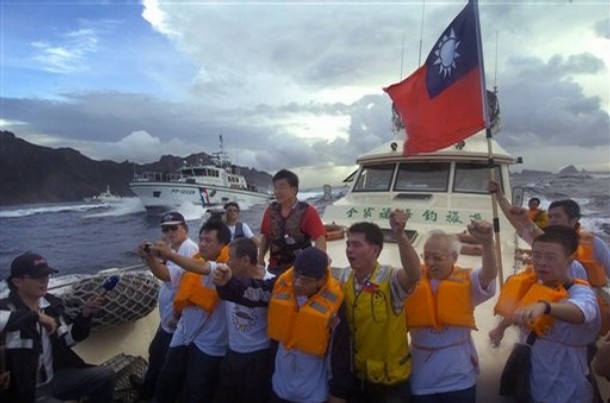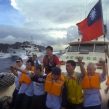
Taiwan and the Changing Strategic Balance in the East China Sea
Publication: China Brief Volume: 9 Issue: 24
By:

On October 19, Legislator and Chairman of Congressional Caucus for the opposition party DPP (Taiwan Democratic Progressive Party) Chai Trong-rong publicly accused the Ma Ying-jeou administration of providing China with sensitive undersea survey data around Taiwan. Legislator Chai maintained that the information, which he alleged the Ma administration supplied, was germane to China’s May 11 submission of the preliminary survey findings on the outer limits of its continental shelf to the U.N. Commission on the Limits of the Continental Shelf (UNCLNS) on the East China Sea. The government denied the allegation (Taipei Times, October 20). Such charges highlight the deep-seated suspicion held by the opposition party toward the Kuomintang (KMT)-led government. Yet whether Chai’s accusation proves to be true or false, the Ma administration has indeed taken a very different approach than the previous administration toward China and Japan in maritime issues related to the East China Sea and Taiwanese-claimed territorial waters.
For instance, the Taiwanese-media recently disclosed that the Ma administration is no longer claiming the territorial waters around Kinmen and Matsu, two small islands that have long been part of its frontline defense against China (Liberty Times, November 23). These two major cases constitute a growing body of evidence signaling that a major shift is underway in Taiwan’s strategic orientation, particularly in its maritime domain. Taiwan, an island strategically located at the crossroad of the western Pacific Ocean and Continental Asia, pivots on the sea-lane of communications (SLOCs) between Northeast and Southeast Asia. Taiwan’s strategic orientation, whether it folds in line with continental Asia or maritime Asia, has the potential to fundamentally alter the strategic landscape in the western Pacific.
China Becomes Taiwan’s Partner in the East China Sea
Mending relations with China has been the cornerstone of President Ma’s foreign policy. Throughout his political career, Ma has consistently advocated that “cross-Strait relation outweighs all other Taiwan’s external relations” (Liberty Times, June 10, 2008). Indeed, since his electoral victory in the March 2008 presidential election, cross-Strait relations have thawed considerably. This may be attributable to President Ma’s acceptance of the so-called “92 consensus” as the basis on which to resume official dialogue with the PRC. In his inauguration speech as KMT (Chinese Nationalist Party) chairman on October 18, President Ma stated that the “92 consensus" means that both sides accept the “one China principle," (Economic Times, October 19), yet both sides are free to interpret what "China" means [Republic of China or People’s Republic of China] (Hong Kong Central News Agency, October 18).
In addition to increasing official-contacts between Taipei and Beijing, cross-Strait cooperation has also expanded into strategic areas. One of these strategic areas involves cooperation in the East China Sea. Chinese National Petroleum (CNP), a Taiwanese state-owned oil company, has intensified its joint oil-exploration cooperation efforts in the South China and East China Sea with China National Offshore Oil Corporation (CNOOC), a PRC government-owned oil company. In a 2002 research study conducted by a KMT-affiliated think tank, National Policy Foundation, the author called for closer cooperation with China in the areas of oil exploration in the midline of the Taiwan Strait. Three days after his inauguration, President Ma reportedly ordered an interagency study on the possibility of Taiwan-China Petroleum cooperation. According to the National Security Council’s (NSC) original planning, future focus will be on cross-Strait cooperation for oil and gas exploration in the South China Sea, the East China Sea and other offshore resources through setting up a cross-Strait joint venture (China Times, October 26, 2008). Yin Chi-min, then the Taiwanese Minister of Economy, stressed that one of the aims for accelerating cross-Strait petroleum cooperation is to enhance Taiwanese energy security (TTV.com.tw, March 16).
According to a senior Taiwanese official in the NSC, one purpose for Taiwan-China petroleum cooperation is to balance against Japan and Vietnam oil and gas exploration activities in the East and South China Sea, respectively (China Times, October 26). Indeed, cross-Strait cooperation in these areas could ameliorate the general atmosphere across the Taiwan Strait and improve political confidence on both sides as well. Implicit in this cooperation, however, is that China—Taiwan’s primary strategic adversary—is being framed by the current Taiwanese government as a strategic partner for its energy security against Vietnam and Japan, countries that Taiwan has previously had friendly relations with under the previous administration.
Taiwan-Japan Tension Increased After Ma Took Office
Taiwan-Japan relations represent another example of significant change in Taiwan foreign relations, one which is altering the regional dynamics. Despite President Ma’s claim that 2009 marks the year of "Special Partnership of Taiwan and Japan," (Central News Agency, January 20) less than a month after taking office, a Taiwanese fishing boat entered disputed waters near Senkaku Island /Diaoyutai and the event quickly escalated into an all-out diplomatic fistfight between Taipei and Tokyo (China Post, September 1). Then Premier Liu Chao-hsuan publicly threatened to use military force if necessary to uphold Taiwan’s sovereignty claim over the Senkaku/Diaoyutai area (Taiwan News, June 16). Taiwan’s chief representative to Japan was recalled to protest against Japan. On June 16, Taipei also dispatched coast guard ships to guard a civilian fishing boat that entered the disputed area to proclaim sovereignty (Central News Agency, June 17). At the same time, Jian Yu, the spokesperson for China’s ministry of foreign affairs, restated the Chinese position that Diaoyutai/Senkaku is part of Chinese territory and expressed deep concern and anger toward Japan about sinking the Taiwanese ship. He also demanded that Japan stop its "illegal activity around this area" (Wenwei Pao, June 18).
As Taiwan-Japan relations continued to deteriorate into a state of diplomatic cold war after the fishing vessel incident, the Japanese Defense Ministry confirmed a Tokyo Shinbum report that it was studying plans to deploy self-defense forces on Yonagoni-Jima, which lies 67 miles (108 kilometers) from the east coast of Taiwan (Taiwan News Online, July 4). In response to this report, the Ma administration asked Tokyo to exercise self-restraint. The proposal to base military units at a time when cross-Strait tension was at an all-time low sparked a lot of speculation. Some analysts pointed out that such a move by Japanese Self Defense Forces indicates that Tokyo’s views toward Taiwan are changing, and that the island may now become a target that Japan may need to defend “against,” rather than to defend “with” (FTV English News, July 3; Taipei Times, July 6). According to the Japanese Defense Ministry spokesperson, "the [Japanese] government is currently studying this military deployment and that it will be added to the nation’s basic self-defense plans scheduled to be revised at the end of this year" (United Daily News [Taiwan], July 3).
The Collateral Damage of Ma’s Sino-centric Foreign Policy
The opposite directions in which Taiwan-China and Taiwan-Japan relations appear to be moving raises questions about the Ma administration’s capability to wage its “comprehensive diplomacy.”
Proponents of Ma’s strategy explain that this hurdle in bilateral relations is a normal development for every incoming administration; especially since the ruling-party has been in opposition for the previous eight years. This worsening development between Taiwan and Japan can be attributed to the inexperience of the incoming new government, the lack of “Japan hands” within the administration, and the deep-seated “anti-Ma” complex among some Japanese political elites. According to this school of thought, the tension will eventually go away as the administration gradually gets familiar with all the nuts and bolts of Japan affairs. It can also be argued that lowering tension across the Taiwan Strait fits Japan’s national interest as well, thus there should be no reason for Japan to oppose Ma’s foreign policy since Japan’s basic national interest is fundamentally met due to Ma’s action.
Yet, critics of Ma’s strategy believe this development is the direct result of Ma Ying-Jeou’s own “great Chinese nationalism complex,” which sees Japan through the eyes of China, rather than viewing it from the angle of Taiwanese national interest (Liberty Times, June 22, 2008). In terms of the Senkaku/Diaoyutai dispute, Ma’s actions reneged from the tacit understanding between Taipei and Tokyo established during the previous Lee and Chen administrations. This understanding is based on a set of unstated protocols that in the event of a conflict Taipei will not send its governmental ship into the troubled area; that Taiwan will adhere to the principle of non-violence; and that this issue will remain a strictly bilateral matter between Taiwan and Japan. At the height of the Lien-Ho fishing boat tension in June 2008, between then-Premier Liu’s war talk, Ma’s pending decision to send Taiwanese naval vessels to escort civilian fishing boats entering the disputed water (Taipei Times, June 17), and a KMT legislator’s suggestion to “unite with China against Japan" (lianzhong zhiri), the Ma government broke all of the cardinal precedents of managing Taiwan-Japan relations over the East China Sea issue. Taiwan-Japan relations have not been the same since.
From the Taiwan Strait to the East China Sea: Changing Strategic Balance
The first 18 months of Ma’s administration have altered the long-standing strategic balance in the East China Sea. In spite of the territorial dispute between Taiwan and Japan, Tokyo could always count on Taipei to be a cooperative partner. Under the previous two administrations, at the very least, Taipei would not take Beijing’s side when Japan-China disputes flared up. Now that the Taiwanese government appears to be changing its position by taking a pro-China stance, Japan will face opposition not only from its Western front, but also from its Southern front if the East China Sea dispute flares up again.
This development could also pose a strategic challenge to the U.S.-Japan alliance. If Taiwan is no longer willing to play a silent but supportive role in strengthening the U.S.-Japan alliance, it may have to prepare for the possibility that Taipei will forge a common position with China in some cases; for instance, in the Diaoyutai/Senkaku island dispute and cross-Strait oil/gas joint exploration in the East China Sea. Thus, the alliance’s capability and freedom of action will be complicated by the uncertainty in Taipei’s actions. Yet, an all-out “Chiawan” (China-Taiwan) cooperation seems unlikely in the near future, but the fundamentals of the East China Sea strategic equation are undergoing long-term changes. It seems clear from President Ma’s policy announcements, which prioritize cross-Strait relations above all other external relations, that as long as Ma remains in office, lowering tensions across the Taiwan Strait will be followed by increasing strategic uncertainty in the East China Sea.
Notes
1. Guo Boyao, "Studying the Development of Taiwan’s Oil Industry from Cross-Strait Oil Exploration," National Policy Foundation Research Report, May 29, 2002.
2. This is based on author’s personal experience dealing with the Taiwan-Japan issue working at Taiwan’s representative office in Japan 2000-2003.





